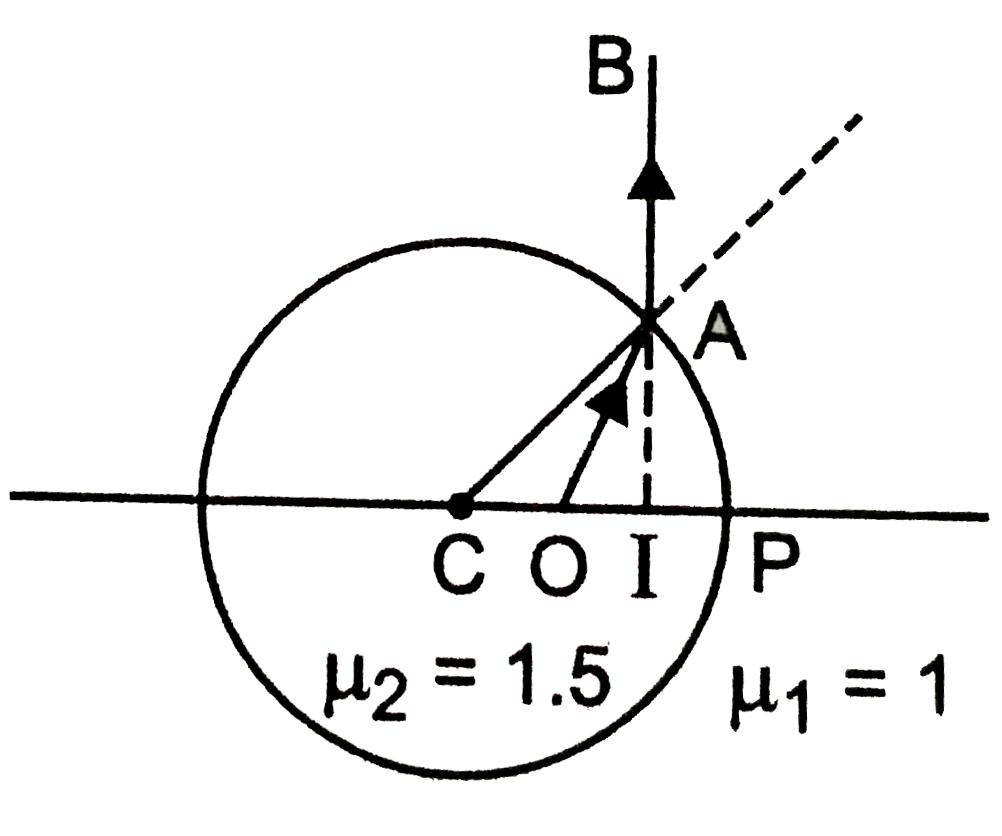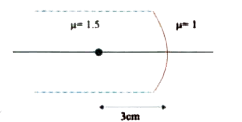A glass paper weight (n = 1.5) of radius 3 cm has a tiny air bubble trapped inside it. Closest distance of the bubble from the surface is 2 cm. Where will it appear, when seen from the other end from where it is the farthest?Solution in Marathi
Step by step video & image solution for A glass paper weight (n = 1.5) of radius 3 cm has a tiny air bubble trapped inside it. Closest distance of the bubble from the surface is 2 cm. Where will it appear, when seen from the other end from where it is the farthest? by Physics experts to help you in doubts & scoring excellent marks in Class 11 exams.
Updated on:21/07/2023Topper's Solved these Questions
Similar Questions
A car travels at a speed of 50 km/hr for 15 minute and then 70 km/hr for next 45 minutes. What is the average speed of the car?
View SolutionWhat do you mean by semiconductor?
View SolutionAn air bubble is seen inside a solid sphere of glass (n=1.5) of 4.0 cm diameter at a distance of 1.0 cm from the surface of the sphere (on seeing along the diameter). Determine the real position of the bubble inside the sphere.
View SolutionA small air bubble in a glass sphere of radius 2cm appears to be 1cm from the surface when looked at, along a diameter. If the refractive index of glass is 1.5, find the true position of the air bubble.
 .
.
View SolutionAn air bubble in sphere having 4cm diameter appears of 1 cm from surface nearest to eye when looked along diameter. If nga = 1.5, the distance of bubble from refracting surface is
View SolutionAn air bubble in a glass sphere (mu = 1.5) is situated at a distance 3 cm from a convex surface of diameter 10 cm . At what distance from the surface will be the bubble appear ?
View Solutionकाँच (n = 1.5) के 4.0 सेमी व्यास के एक ठोस गोले के भीतर वायु का एक बुलबुला गोले के पृष्ट से ( व्यास के अनुदिश देखने पर ) 1.0 सेमी की दूरी पर दिखाई देता हैं | गोले के भीतर बुलबुले की वास्तविक स्थिति ज्ञात कीजिए |
View Solution6 cm त्रिज्या तथा 1.5 अपवर्तनांक वाले एक काँच के गोले में हवा का एक छोटा बुलबुला, यदि इसमें से होकर गुजरनेवाले व्यास की और से देखा जाए, तो पास वाली सतह से 2 cm पर मालूम पड़ता है। बुलबुले की वास्तविक स्थिति ज्ञात करे।
View Solutionकाँच के एक गोले की त्रिज्या 3 सेमी है। उसके अन्दर गोले के केन्द्र से 1 सेमी की दूरी पर वायु का एक बुलबुला है। यदि काँच का अपवर्तनांक 1.5 है, तो (i) बुलबुला के निकट वाले पृष्ठ से देखने पर, (ii) बुलबुले के दूर वाले पृष्ठ से देखने पर वह कितनी दूर दिखाई देगा ?
View Solutionत्रिज्या 4 सेमी के काँच (aμg=1⋅5) के एक गोले के केंद्र से दुरी 1 सेमी पर वायु का एक बुलबुला है | यदि उसे बुलबुले के दूर वाले पृष्ठ से देखा जाए तो वह कहाँ दिखायी देगा ?
View Solution4 सेमी त्रिज्या के काँच के एक गोले (μ=1.5) के केंद्र से 1 सेमी की दूरी पर वायु का एक बुलबुला है। यदि उसे -
(i) बुलबुले के निकट वाले पृष्ठ से (ii) बुलबुले के दूर वाले पृष्ठ से देखा जाये तो वह कहाँ दिखाई देगा।
View SolutionOne end of a cylindrical glass ( mu = 1.5) is given the shape of a concave refracting surface of radius 10 cm. An air bubble is situated in the glass rod at a point on its axis such that it appears to be at distance 10 cm from the surface and inside glass when seen from the other medium. Find the actual location of air bubble.
View SolutionA spherical solid glass paper weight of diameter 6 cm has a small air bubble at a distance of 1.5 cm from the centre. If the air bubble be viewed from the side to which it is nearest along the line joining the bubble and the centre, find where will it appear.
View SolutionAn air bubble in glass (μ = 1.5) is situated at a distance 3 cm from a convex surface of diameter 10 cm as shown. The distance from surface at which the image of bubble appears is

View SolutionA small air bubble is situated at a distance of 3 cm from the center of a glass sphere of radius 9 cm. When viewed from the nearest side, the bubble appears to be at a distance of 5 cm from the surface. Its apparent distance when viewed from the farthest side is nxx5 cm where n is?
View SolutionOne end of a cylindrical glass rod (mu = 1.5) is given the shape of a concave refracting surface of radius 10cm. An air bubble is situated in the glass rod at a point on its axis such that it appears to be at distance 10 cm from the surface and inside glass when seen from the other medium. Find the actual location of air bubble.
View Solution
